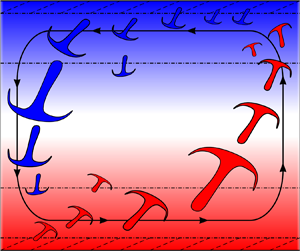Article contents
Model for classical and ultimate regimes of radiatively driven turbulent convection
Published online by Cambridge University Press: 13 August 2020
Abstract

In a standard Rayleigh–Bénard experiment, a layer of fluid is confined between two horizontal plates and the convection regime is controlled by the temperature difference between the hot lower plate and the cold upper plate. The effect of direct heat injection into the fluid layer itself, for example by light absorption, is studied here theoretically. In this case, the Nusselt number ( $Nu$) depends on three non-dimensional parameters: the Rayleigh (
$Nu$) depends on three non-dimensional parameters: the Rayleigh ( $Ra$) and Prandtl (
$Ra$) and Prandtl ( $Pr$) numbers and the ratio between the spatial extension of the heat source (
$Pr$) numbers and the ratio between the spatial extension of the heat source ( $l$) and the height of the fluid layer (
$l$) and the height of the fluid layer ( $h$). For both the well-known classical and ultimate convection regimes, the theory developed here gives a formula for the variations of the Nusselt number as a function of these parameters. For the classical convection regime, by increasing
$h$). For both the well-known classical and ultimate convection regimes, the theory developed here gives a formula for the variations of the Nusselt number as a function of these parameters. For the classical convection regime, by increasing  $l/h$ from 0 to 1/2,
$l/h$ from 0 to 1/2,  $Nu$ gradually changes from the standard scaling
$Nu$ gradually changes from the standard scaling  $Nu \sim Ra^{1/3}$ to an asymptotic scaling
$Nu \sim Ra^{1/3}$ to an asymptotic scaling  $Nu \sim Ra^{{\theta }}$, with
$Nu \sim Ra^{{\theta }}$, with  $\theta =2/3$ or
$\theta =2/3$ or  $\theta =1$ by adopting, respectively, the Malkus (Proc. R. Soc. A, vol. 225, 1954, pp. 196–212) theory or the Grossmann & Lohse (J. Fluid Mech., vol. 407, 2000, pp. 27–56) theory. For the ultimate convection regime,
$\theta =1$ by adopting, respectively, the Malkus (Proc. R. Soc. A, vol. 225, 1954, pp. 196–212) theory or the Grossmann & Lohse (J. Fluid Mech., vol. 407, 2000, pp. 27–56) theory. For the ultimate convection regime,  $Nu$ gradually changes from
$Nu$ gradually changes from  $Nu \sim Ra^{1/2}$ scaling to an asymptotic behaviour seen only at very high
$Nu \sim Ra^{1/2}$ scaling to an asymptotic behaviour seen only at very high  $Ra$ for which
$Ra$ for which  $Nu \sim Ra^{2}$. This theory is validated by the recent experimental results given by Bouillaut et al. (J. Fluid Mech., vol. 861, 2019, R5) and also shows that for these experiments,
$Nu \sim Ra^{2}$. This theory is validated by the recent experimental results given by Bouillaut et al. (J. Fluid Mech., vol. 861, 2019, R5) and also shows that for these experiments,  $Ra$ and
$Ra$ and  $Re$ numbers were too small to observe the ultimate regime. The predictions for the ultimate regime cannot be confirmed at this time due to the absence of experimental or numerical work on convection driven by internal sources and for very large
$Re$ numbers were too small to observe the ultimate regime. The predictions for the ultimate regime cannot be confirmed at this time due to the absence of experimental or numerical work on convection driven by internal sources and for very large  $Ra$ numbers.
$Ra$ numbers.
Information
- Type
- JFM Papers
- Information
- Copyright
- © The Author(s), 2020. Published by Cambridge University Press
References
REFERENCES
- 8
- Cited by

